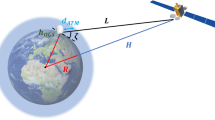Abstract
The paper presents results of pulsed radar signal interference impact on multiple-input and multiple-output (MIMO) Long Term Evolution (LTE) downlink data service analysis. Interference from radar operating in 800 MHz frequency band is studied analytically and experimentally taking into account MIMO capacity performance under external interference, including the influence of radar orientation with respect to LTE receiver antenna.







Similar content being viewed by others
References
Krivochiza, J., Aleksiejunas, R., Svirskas, K., Dzindzeleta, B., Pantelejev, A., Zverelo, J., et al. (2013). Modeling of radar interference impact on VoLTE service. In Proceedings of 21st Telecommunications Forum, TELFOR (p. 25).
Catreux, S., Driessen, P., & Greenstein, L. (2000). Simulation results for an interference-limited multiple-input multiple-output cellular system. IEEE Communications Letters, 4(11), 334. doi:10.1109/4234.892193.
Blum, R. (2003). MIMO capacity with interference. IEEE Journal on Selected Areas in Communications, 21(5), 793. doi:10.1109/JSAC.2003.810345.
Chiani, M., Win, M. Z., & Shin, H. (2010). MIMO networks: The effects of interference. IEEE Transactions on Information Theory, 56(1), 336. doi:10.1109/TIT.2009.2034810.
Kim, K., & Stber, G. L. (2007). Interference mitigation in MIMO systems by subset antenna transmission. Wireless Personal Communications, 40(3). doi:10.1007/s11277-006-9192-9.
Bouras, C., Diles, G., Kokkinos, V., Kontodimas, K., & Papazois, A. (2014). A simulation framework for evaluating interference mitigation techniques in heterogeneous cellular environments. Wireless Personal Communications, 77(2). doi:10.1007/s11277-013-1562-5.
Siomina, I., & Yuan, D. (2012). Analysis of cell load coupling for LTE network planning and optimization. IEEE Transactions on Wireless Communications, 11(6), 2287. doi:10.1109/TWC.2012.051512.111532.
3GPP. (2011). 3GPP TS 36.213. Evolved universal terrestrial radio access (e-UTRA); physical layer procedures. Tech. Rep. Rel-10.
Kuebler, W., & Cameron, S. (1979). The definition of frequency-dependent rejection. IEEE Transactions on Electromagnetic Compatibility EMC, 21(4), 349. doi:10.1109/TEMC.1979.303777.
Liu, W., Fang, J., Tan, H., Huang, B., & Wang, W. (2010). Coexistence studies for TD-LTE with radar system in the band 2300–2400 MHz. In Proceedings of International Conference on Communications, Circuits and Systems, ICCCAS (p. 49).
Fan, J., Yin, Q., Li, G. Y., Peng, B., & Zhu, X. (2011). MCS selection for throughput improvement in downlink LTE systems. In Proceedings of 20th International Conference on Computer Communications and Networks, ICCCN (p. 1).
Parruca, D., Grysla, M., Gortzen, S., & Gross, J. (2013). Analytical model of proportional fair scheduling in interference-limited OFDMA/LTE networks. In Proceedings of IEEE 78th Vehicular Technology Conference, VTC Fall (p. 1).
Bliss, D. W., Forsythe, K. W., Hero, A. O., & Swindlehurst, A. L. (2000). MIMO environmental capacity sensitivity. In Conference Record of the Thirty-Fourth Asilomar Conference on Signals, Systems and Computers (Vol. 1, p. 764).
Farrokhi, F., Foschini, G., Lozano, A., & Valenzuela, R. (2001). Link-optimal space-time processing with multiple transmit and receive antennas. IEEE Communications Letters, 5(3), 85. doi:10.1109/4234.913148.
Kwak, J., Andrews, J., & Lozano, A. (2007). MIMO capacity in correlated interference-limited channels. In Proceedings of IEEE International Symposium on Information Theory, ISIT (p. 106).
Lozano, A., Tulino, A., & Verde, S. (2003). Multiple-antenna capacity in the low-power regime. IEEE Transactions on Information Theory, 49(10), 2527. doi:10.1109/TIT.2003.817429.
Trump, T., & Ottersten, B. (1996). Estimation of nominal direction of arrival and angular spread using an array of sensors. Signal Processing, 50(1–2), 57. doi:10.1016/0165-1684(96)00003-5.
Sleiman, A., & Manikas, A. (2000). Antenna array manifold: a simplified representation. In Proceedings of IEEE International Conference on Acoustics, Speech, and Signal Processing, ICASSP (Vol. 5, p. 3164).
Caban, S., Mehlfuhrer, C., Mayer, L. W., & Rupp, M. (2008). \(2\times 2\) MIMO at variable antenna distances. In Proceedings of IEEE Vehicular Technology Conference, VTC Spring, (p. 1311).
Heino, P. (ed.) (2010). WINNER+ final channel models. Tech. Rep. D5.3.
Author information
Authors and Affiliations
Corresponding author
Rights and permissions
About this article
Cite this article
Aleksiejunas, R., Krivochiza, J., Aleksandravicius, J. et al. Analysis of Radar Interference Effects on MIMO LTE Downlink Performance. Wireless Pers Commun 82, 1719–1731 (2015). https://doi.org/10.1007/s11277-015-2308-3
Published:
Issue Date:
DOI: https://doi.org/10.1007/s11277-015-2308-3




